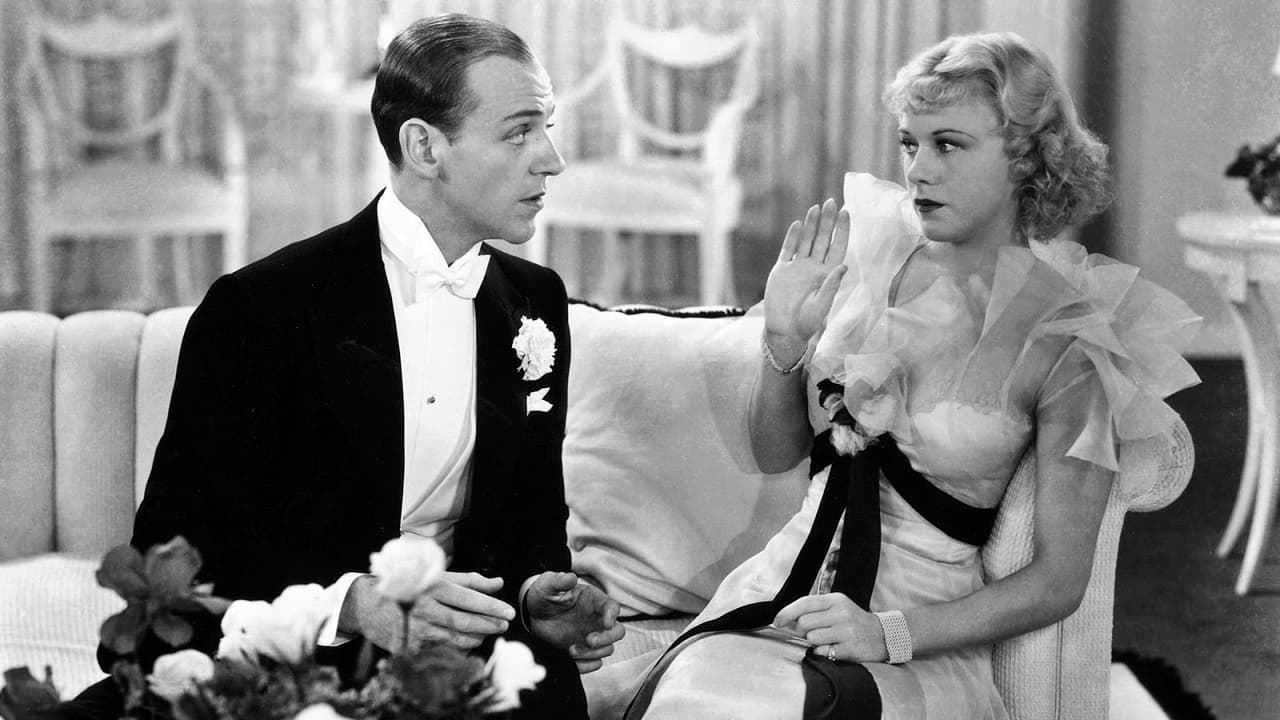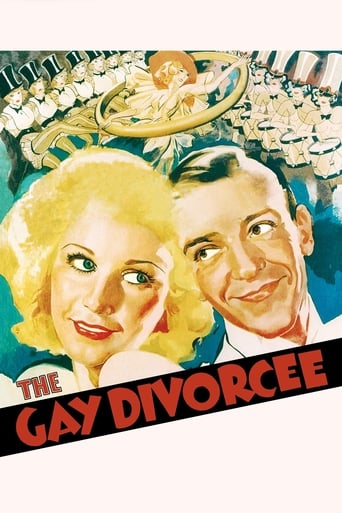

. . . but Fred Astaire goes Jimmy one better by playing a shameless DEARSTALKER in this two-hit musical, THE GAY DIV0RCEE. Though "The Continental" is primarily notable for being a tune in the tradition of Glenn Miller's "In the Mood" (that is, a song that NEVER ends: "The Continental" drags on in one form or another for nearly 17 minutes!), as well as for winning the first-ever "Best Song" Oscar (apparently more Academy members ran marathons back then), Cole Porter's "Night and Day" steals "The Continental's" thunder. Beyond these two musical numbers, the next most remarkable ditty in this sex farce involves lyrics encouraging folks to Bump Uglies or Knock Knees or something. Though the movie studio RKO is desperately trying to ape Warner Bros.' Busby Berkeley in their geometric "Continental" chorus line groupings, this only serves to dilute the Oomph which Fred Astaire and Ginger Rogers would otherwise provide to it. During the early going of DIV0RCEE, Freddy is nearly as creepy stalking Ginger as his ROYAL WEDDING character is in pursuing a Real Life sister, and likely could give Mr. Krueger a run for his money if they had a Creep-Out Race on ELM STREET.
... View MoreI was in an awful mood when I started watching THE GAY Divorcée, but by the time I was finished everything seemed right with the world. Can you say anything better about a film?THE GAY Divorcée is the first proper 'Fred and Ginger' film, a rewritten and re-scored version of a successful musical play that Astaire had performed in New York and London. By most testimonies it's the best version despite having jettisoned most of Cole Porter's score (the exception being the brilliant 'Night and Day'). Replacement songs included 'The Continental', first Academy Award winner for Best Original Song (Night and Day, of course, wasn't eligible) and the even better 'Needle in a Haystack'. And Divorcée serves as a template for much of what will follow in the series. In most ways, few of their later efforts would better it.As in most of the Astaire/Rogers musicals we get a standard French Farce type of plot grounded in mistaken identities and general misunderstandings within which are strung various Vaudevillian-type comedy routines featuring a superb supporting cast (Edward Everett Horton, Alice Brady, the two Erics, even Betty Grable) and several dances by our principals. THE GAY Divorcée differs from the others in having two of our supporting actors (Horton and Grable) doing the terpsichorean honors in the first (happy, high-spirited, allegro, getting-to-know-you style) duet, and as good as Betty (only seventeen) is, and as fun as it is to see Horton shuffling about (he actually had experience on the stage in musical comedies), the routine (Let's K-Knock Knees) pretty much stops the movie dead, and I for one very much miss Ginger and Fred in it. Without them the little production number does nothing to further the plot, an innovation that this series pioneered (apparently director Mark Sandrich made a major contribution in this respect).You can't say the same about the great duet danced to 'Night and Day'. Something of a choreographic miracle (Fred had never designed a romantic duet before), it remains one of the finest dances ever put on film despite a certain stiffness on Ginger's part, a deficiency (she was not a trained dancer and had never done anything like this) that she would overcome in later films, and which was more than made up for by her brilliant acting ability, bringing an emotional clarity and depth to the number that would later prove to be lacking with many of the technically better trained partners of Astaire.The perfect introduction to Astaire's genius is his earlier solo to 'Needle in a Haystack', a wonderful example of complexity within simplicity as he dresses to go out looking for Ginger while manipulating props, combining explosions of tap with flashes of ballet, and making everything seem absolutely effortless while doing so. He would do more elaborate solos later on, but for my taste he would never do a better one.The celebratory Continental dance, however, is charming so long as Fred and Ginger are doing the dancing but goes on far too long when the chorus takes over. No such problem for our delightful epilogue, a joyous dance over the furniture and out the door, whetting the audience's appetite for more.I find the comedy funnier in THE GAY Divorcée than in any of the other Astaire/Rogers films, with wonderfully witty lines delivered by expert performers popping up everywhere. Besides the great dancing and electric chemistry between them, Fred was a perfectly competent light comedian, exceptional in a great dancer, and an excellent singer (in manner if not in the quality of his voice), while Ginger was an excellent actress of extraordinary range, positively unique in someone who could do dances of the complexity and difficulty that she could manage. It isn't any surprise that we haven't seen their likes since.
... View More" . . . if you can blend the two," Aunt Hortense advises her niece Mimi (Ginger Rogers). Why not be an instant winner of Dancing with the Stars, too? The premise of THE GAY DIV0RCEE is that pro hoofer Guy Holden (Fred Astaire) falls in love with a geologist's estranged\neglected\divorce-minded wife (Mimi). Furthermore, whenever he smiles at her, she can instantly dance backwards upstairs and across furniture by the unexplained magic of his proximity. She's rich enough to drive something that looks like a Dusenberg, and it just takes a few sappy love songs (such as Cole Porter's "Night and Day") to make Mimi fall for Guy's charms. "Best original song" always has been the strangest Oscar Award category, and the first winner from THE GAY DIV0RCEE sets the pattern. This 16-minute, 50-second (!) song--"The Continental"--features a patio full of random night club dancers getting sprinkled with Astaire's fairy dust and suddenly appearing in coordinated show costumes, dancing in formation like something from the mind of that old drill sergeant, Busby Berkeley!
... View MoreAfter staying in Paris on vacation, the American dancer Guy Holden (Fred Astaire) and his Londoner lawyer friend Egbert Fitzgerald (Edward Everett Horton) return to London by ship. Guy meets the wealthy American blonde Mimi Glossop (Ginger Rogers), who is traveling with her aunt Hortense Ditherwell (Alice Brady), in the harbor and Mimi asks him to call her aunt to open her luggage since her dress is trapped in the trunk. Guy tries to release her dress but he accidentally rips Mimi's dress. Guy lends his overcoat to her expecting to receive it back with a thank-you note with her name and address, but Mimi returns the coat without any card.Meanwhile, Hortense seeks out Egbert, who is replacing his father in the office, expecting to get the divorce of Mimi and her husband, the geologist Cyril Glossop (William Austin). However, Cyril advises that it would be difficult to make Cyryl accepting the divorce and he suggest to Mimi to hire the "correspondent" Rodolfo Tonettito (Erik Rhodes) to stay with her in a hotel room. Meanwhile, Egbert would hire private eyes to arrive in Mimi's room and surprise the couple, forcing the divorce of Mimi and Cyril. Egbert gives a password to Tonettito to identify Mimi and uses a sentence created by Guy – "Chance Is the Fool's Name for Fate". Mimi believes that Guy is her correspondent and stays with him in her room. When Tonettito arrives in her room, the disappointed Mimi learns the truth and feels better. But she is still married and can not marry Guy. "The Gay Divorcée" is a great classic musical, with Ginger Rogers and Fred Astaire shining and dancing. The long song "The Continental" was awarded with the Oscar of Best Music in 1935 and it is delightful to see the choreography of the dance. In IMDb Trivia, there are interesting information about this film that I will not repeat in my review. In addiction, Ginger Rogers drives the mighty Duesenberg Model J, one of the most popular luxury cars as well as a status symbol in the United States and Europe. This car that cost between US$ 20,000.00 to US$ 25,000.00 in 1935 was driven by Clark Gable and Gary Cooper (the rare model SSJ 125), Al Capone, Greta Garbo, Howard Hughes, Mae West, Tyrone Power among others personalities. My vote is seven.Title (Brazil): "A Alegre Divorciada" ("The Gay Divorcée")
... View More